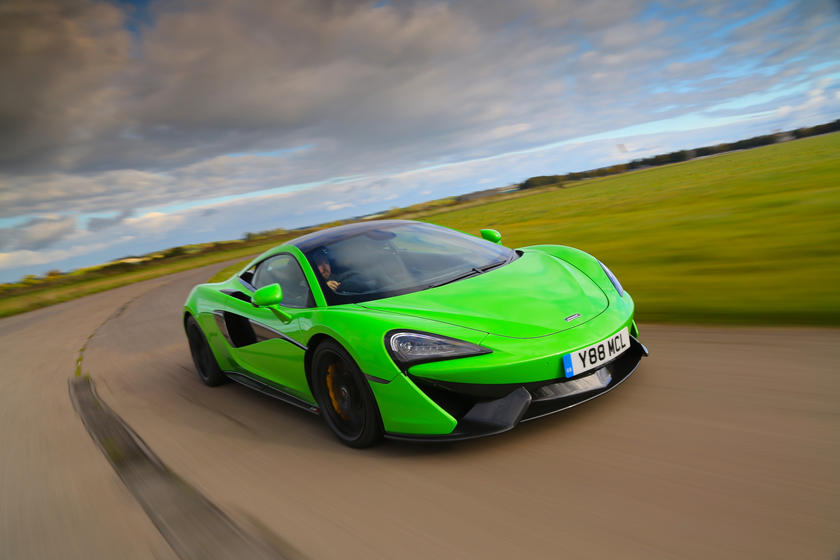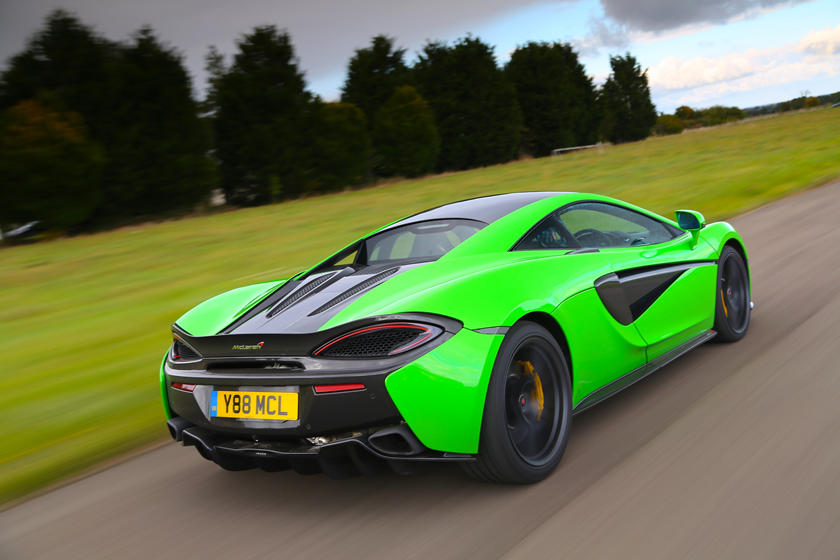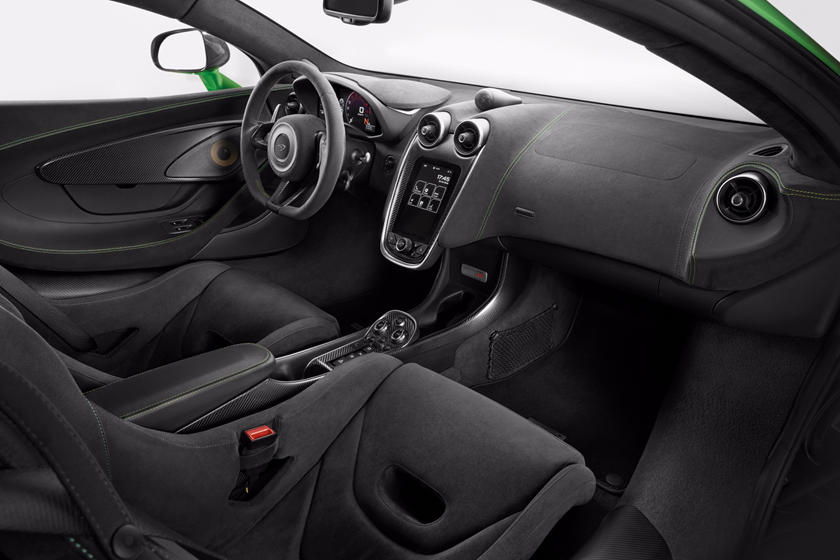There are few supercars today that do so many things as well as the McLaren 570S. This supercar is not only comparatively affordable, but offers the performance and handling to match its fiercely attractive looks. The McLaren 570S is all about the driver-orientated driving experience and feels as at home on the track as it does on the road. With a curb weight lower than its rivals and the highest power-to-weight ratio in its class, performance can be described as explosive. Power is provided by a 3.8-liter twin-turbocharged V8 engine that produces 562 hp and 443 lb-ft of torque. Power is sent to the rear via a seven-speed dual-clutch transmission. The McLaren 570S goes up against accomplished rivals such as the Acura NSX, and the Audi R8 Coupe.
The 570S was first unveiled in 2015 at the New York Auto Show and is powered by a different version of the 3.8-liter V8 engine (it's detuned, featuring smaller turbos) which is found in cars such as the 650S and P1. The 570S has been developed with day-to-day usability in mind, hence the increased luggage space, leather interior options, and increased interior storage space.
There are no changes to the 2020 McLaren 570S and the coupe essentially carries over from the 2019 model.
After a few updates to last year's model, McLaren makes no changes to the 2019 570S.
For the 2018 model, McLaren is adding a few additional paint colors to the palette and the 570S coupe gets a taller rear spoiler. The gauge cluster, which previously comprised three screens, is simplified and combined into a single, larger digital display, also displaying the image from the backup camera. The existing S coupe is joined by an open-top 570S Spider, which you can read more about in its own review.
For its second model year, McLaren is keeping the 570S coupe as-is and won't be making any changes to it. Owners can personalize it with various packages, such as the Lux package that adds soft-close doors, heated seats, and a better audio system. It is joined by a more luxurious and comfortable 570GT coupe derivative for the 2017 model year - which we review separately.
The McLaren 570S coupe is first unveiled at the 2015 Shangai Motor Show and launches as a 2016 model, with a focus on being more drivable and usable every day than the company's more hardcore supercars. It is also more affordable, becoming the first McLaren with an MSRP of less than $200,000. P1-like tail lights feature, as do the trademark McLaren dihedral doors. In this model, a more mildly tuned version of the well-known McLaren 3.8-liter V8 engine produces 562 hp.
From the outside in, the 570S looks the part of a supercar. The exterior is built around a carbon-fiber MonoCell and features an exposed engine bay, ten-spoke cast alloy wheels finished off in silver and wrapped in Pirelli P ZeroTM Corsa tires, as well as those iconic dihedral doors and LED headlights. Underneath, things are kept steady by an adaptive suspension setup and carbon-ceramic brakes. Under the engine cover lies a flat-plane 3.8-liter twin-turbocharged V8 that produces 562 hp and 443 lb-ft of torque. Power is sent to the rear via a dual-clutch seven-speed transmission. The interior features manually adjustable seats, dual-zone climate control, as well as optional eight-way power-adjustable seats, and a power-adjustable steering column. The infotainment system consists of a seven-inch display with Bluetooth streaming, satellite radio, and eight speakers, and an optional 12-speaker Bowers & Wilkins system is also on offer. Safety features include cruise control and hill start assist.
McLaren’s junior supercar is anything but plain, or slow. With a characterful 3.8-liter twin-turbocharged V8 under the hood, this 562-hp arrow darts through corners with glee, and feels connected to the driver in the purest sense of the word. Standard exterior features include LED headlights, dihedral doors, and carbon-ceramic brakes. Inside the carbon monocoque, you get manually adjustable seats with the option to upgrade to eight-way power-adjustable units, as well as dual-zone climate control and a basic eight-speaker sound system. Safety systems include advanced traction control, hill start assist, and cruise control.
At the heart of the McLaren 570S lies a carbon-fiber MonoCell around which the rest of the car is built. This design gives off all the drama and flair you would expect from a supercar in this price range, and we think it looks absolutely stunning. Exterior feature highlights include the exposed engine bay, ten-spoke cast alloy wheels finished off in silver and wrapped in Pirelli P ZeroTM Corsa tires, as well as those dihedral doors, and LED headlights.
The 570S McLaren is a compact sports car with a total length of 178.3 inches. At its broadest, the 570S measures in at 82.5 inches. Height comes in at a low 47.3 inches with the doors closed and grows to 78.3 inches with the doors in the upright position. Thanks to the extensive use of carbon fiber, the 570S tips the scales at only 3,212 pounds.
McLaren is well versed in the world of F1 racing, and it is clear to see that its experience in this field trickles down into its road-going vehicles. The 570S is powered by a 3.8-liter twin-turbocharged V8 that makes use of a flat-plane crankshaft. The result is an engine that produces 562 hp and 443 lb-ft of torque and revs past 7,500 rpm with glee. This is one soulful engine. Power is sent to the rear wheels via a seven-speed seamless shift transmission with twin multi-plate clutches and an open differential. The 570S can be driven in Normal, Sport, or Track mode, and the built-in launch control nails starts from a dig every time. This is a seriously fast car despite being at the lower end of the McLaren family.
The carbon fiber MonoCell which the 570S is built around offers impressive levels of rigidity, and limits body flex to a bare minimum. This translates into a car that communicates beautifully to every single driver's input, no matter how small. The connected feeling adds great confidence, especially when hitting corners at higher speeds. The adaptive suspension is intuitive and only feels unforgiving in Track mode, while Normal mode sees the 570S ride better than competitors such as the Audi R8. The Pirelli P Zero Corsa tires offer good grip, but we would recommend going for something more sticky on track. The carbon-ceramic brakes do a phenomenal job of bringing this Brit to a halt, with no brake fade, even after prolonged hard driving.
A twin-turbocharged V8 engine doesn't sound like the perfect base for building a fuel-efficient car, and McLaren doesn't even try to hide the fact that the 570S is an eager consumer of gasoline. The numbers read as follows: 15/22/18 mpg city/highway/combined. With a fuel capacity of 19 gallons, the McLaren 570S should see a maximum range of 342 miles.
The interior of the 570S is dominated by carbon fiber; it's everywhere you look and gives this McLaren a Le Mans GT racer feel that truly adds to the overall appeal of this junior McLaren. Lift the signature dihedral doors, and you're faced with a relatively small and low entrance, which could be tricky for taller passengers to make use of. Stepping inside, you're faced with wide door sills and a low seating position. Once inside, there is equal room for both driver and passenger, and we would describe it as snug, especially for taller drivers. The bucket seats are top-class and provide a good balance between support and comfort.
As one of the most practical cars in its class, the McLaren not only offers accessible supercar performance and a comfy ride when set in its most comfortable driving mode, but it is also relatively practical in terms of trunk space. While the rear of the car is stuffed with a V8 engine and turbochargers, the frunk offers 5.3 cubic feet of storage space, which is enough for a small run to the grocery store.
Unlike its more hardcore siblings such as the McLaren Senna, the 570S comes with a good amount of standard comfort features, adding to the 570S' image as an accessible everyday supercar. Standard features include manually adjustable bucket seats, a dimming rearview mirror, a carbon black steering wheel, as well as dual-zone climate control, and a manually adjustable steering column. Optional features include eight-way power-adjustable seats and a power-adjustable steering column.
The infotainment system on the McLaren 570S is a basic one, but it gets the job done nonetheless. What you get is a seven-inch portrait touch screen display that takes center stage in the cabin. This screen is responsive enough and features onboard memory, AM/FM radio, SiriusXM satellite radio, as well as Bluetooth streaming. USB and Aux-in connectivity are also included, as is navigation. Sound is channeled through an eight-speaker standard sound system, and for the serious track-day racers, McLaren's Track Telemetry system is an optional extra. An optional Bowers & Wilkins 12-speaker sound system is also available.
The McLaren 570S has been affected by two recent recalls. The first was due to faulty passenger frontal airbag modules that could fail to inflate. The second was due to a fuel tank issue where trapped debris and water could cause serious corrosion. Other notable recalls include the 2016 model for a dangerous Takata airbag and the 2020 model for possible one-sided brake failure. The McLaren 570S is covered by a three-year basic warranty, a ten-year corrosion warranty, a three-year drivetrain warranty, as well as a three-year roadside assistance plan.
As with most supercars, the McLaren 570S does not come with advanced driver assistance features such as lane-keep assist and rear cross-traffic assist. What you get instead is a basic safety system that includes LED headlights, ABS brakes, an advanced electronic stability and traction control system, as well as hill-hold assist, cruise control, and an electronic parking brake. The McLaren 570S has not been tested by either the NHTSA or IIHS.
NHTSA safety ratings are not available at this time.
The McLaren 570S is one of those special cars that offer a comfortable and relatively practical driving experience, without losing sight of what it truly is: a supercar. Its looks scream "I'm fast," and its twin-turbocharged V8 engine gives it the go to match the looks. It's a beautiful thing to drive and is easy to drive fast, especially if you're a driver with some experience behind the wheel. The interior looks and feels good and is packed with enough features to make it livable on a daily basis. The McLaren 570S manages to be level-headed and soulful at the same time, and that's why we love it.
The McLaren is competitively priced against the competition, but that doesn't mean that it is attainable for the man on the street. With an asking price of $192,500, you could buy a couple of Corvettes or Hellcats instead. The Acura NSX, by comparison, costs $157,500, and the base Audi R8 goes for $169,900.
The McLaren 570S comes well-equipped from the factory, but for some, this will still not be enough, especially when the comforts of a regular premium car are still logged in the mind. Thankfully the 570S comes with front and rear parking sensors. Power-adjustable sport seats, soft close doors, and a 12-speaker Bowers & Wilkins sound system are optional extras, as is a rearview camera.
| Competitor | Horsepower | MPG | Price (MSRP) |
|---|---|---|---|
| McLaren 570S Coupe | 562 hp | 16/23 mpg | $192,500 |
| Audi R8 Coupe | 562 hp | 14/23 mpg | $148,700 |
| Acura NSX | 600 hp | 21/22 mpg | $169,500 |
The R8 is another everyday supercar that offers howling naturally aspirated performance in a beautifully designed and executed package. Power is provided by a 5.2-liter V10 delivering up to 602 horsepower. Power is sent to the rear or all four wheels via a seven-speed dual-clutch transmission. Things we love about the R8 include that sonorous V10 engine and impressive ride quality, as well as its luxurious interior. The Audi R8 does, however, come with minimal safety features. If it's an everyday supercar you're looking for, the Audi is a good bet.
The Acura NSX follows in the footsteps of its forebear by offering well-balanced performance, in conjunction with a premium interior and the ability to be driven on a daily basis. Powered by a twin-turbocharged, 3.5-liter V6 engine and three electric motors, the NSX produces a total system output of 573 horsepower and 476 lb-ft. We love its combo of performance and fuel economy, as well as its precise handling and quick-shifting transmission. The interior materials could do with improving, and the infotainment system is a tad finicky. It's a great all-round supercar, but the McLaren does it with more soul.
The most popular competitors of 2020 McLaren 570S Coupe:





